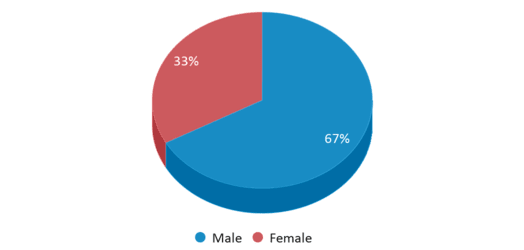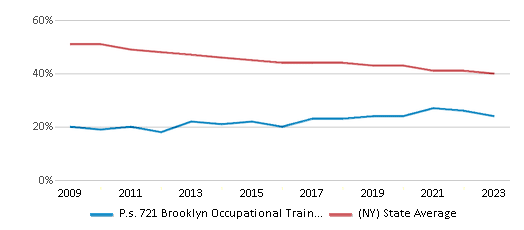P.s. 721 Brooklyn Occupational Training Center serves 450 students in grades Kindergarten-12.
The student:teacher ratio of 5:1 is lower than the New York state level of 11:1.
Minority enrollment is 78% of the student body (majority Black and Hispanic), which is higher than the New York state average of 60% (majority Hispanic and Black).
Quick Stats (2025)
- School Type: Special education school
- Grades: Kindergarten-12
- Enrollment: 450 students
- Student:Teacher Ratio: 5:1
- Minority Enrollment: 78%
- Source: National Center for Education Statistics (NCES), NY Dept. of Education
Top Rankings
P.s. 721 Brooklyn Occupational Training Center ranks among the top 20% of public schools in New York for:
Category
Attribute
Diversity
Percent Eligible For Free Lunch
Student Attention
School Overview
P.s. 721 Brooklyn Occupational Training Center's student population of 450 students has declined by 6% over five school years.
The teacher population of 82 teachers has grown by 22% over five school years.
School Type
Grades Offered
Grades Kindergarten-12
(offers virtual instruction)
(offers virtual instruction)
Total Students
450 students

Gender %

Total Classroom Teachers
82 teachers

Students by Grade

School Rankings
The diversity score of P.s. 721 Brooklyn Occupational Training Center is 0.75, which is more than the diversity score at state average of 0.72. The school's diversity has stayed relatively flat over five school years.
Student : Teacher Ratio
5:1
11:1

American Indian
3%
1%

Asian
13%
10%

Hispanic
25%
30%

Black
36%
16%

White
22%
40%

Hawaiian
n/a
n/a
Two or more races
1%
3%
All Ethnic Groups



Participates in the National School Lunch Program (NSLP)
Yes
Eligible for Free Lunch
91%
54%

Eligible for Reduced Lunch (15-16)
1%
5%

School Statewide Testing
School District Name
Source: National Center for Education Statistics (NCES), NY Dept. of Education
Profile last updated: 02/09/2025
Frequently Asked Questions
How many students attend P.s. 721 Brooklyn Occupational Training Center?
450 students attend P.s. 721 Brooklyn Occupational Training Center.
What is the racial composition of the student body?
36% of P.s. 721 Brooklyn Occupational Training Center students are Black, 25% of students are Hispanic, 22% of students are White, 13% of students are Asian, 3% of students are American Indian, and 1% of students are Two or more races.
What is the student:teacher ratio of P.s. 721 Brooklyn Occupational Training Center?
P.s. 721 Brooklyn Occupational Training Center has a student ration of 5:1, which is lower than the New York state average of 11:1.
What grades does P.s. 721 Brooklyn Occupational Training Center offer ?
P.s. 721 Brooklyn Occupational Training Center offers enrollment in grades Kindergarten-12 (offers virtual instruction).
What school district is P.s. 721 Brooklyn Occupational Training Center part of?
P.s. 721 Brooklyn Occupational Training Center is part of Nyc Special Schools - District 75 School District.
In what neighborhood is P.s. 721 Brooklyn Occupational Training Center located?
P.s. 721 Brooklyn Occupational Training Center is located in the Gravesend neighborhood of Brooklyn, NY. There are 11 other public schools located in Gravesend.
School Reviews
Review P.s. 721 Brooklyn Occupational Training Center. Reviews should be a few sentences in length. Please include any comments on:
- Quality of academic programs, teachers, and facilities
- Availability of music, art, sports and other extracurricular activities
Recent Articles

How Scaffolding Could Change the Way Your Child Learns
This article explores the concept of instructional scaffolding, a teaching method that enhances learning by breaking down complex tasks into manageable parts. It highlights how scaffolding supports students in developing critical thinking skills and becoming more independent learners. The article discusses the benefits of scaffolding, including improved engagement and reduced anxiety, and provides strategies for its implementation across various educational levels.

The Impact of Coronavirus on Public Schools
This article discusses the widespread impact of COVID-19 on public schools, addressing issues such as school closures, remote learning challenges, effects on standardized testing, and concerns about student progress. It also provides tips for parents suddenly faced with homeschooling responsibilities.

February 05, 2025
Understanding the U.S. Department of Education: Structure, Impact, and EvolutionWe explore how the Department of Education shapes American education, from its cabinet-level leadership to its impact on millions of students, written for general audiences seeking clarity on this vital institution.






